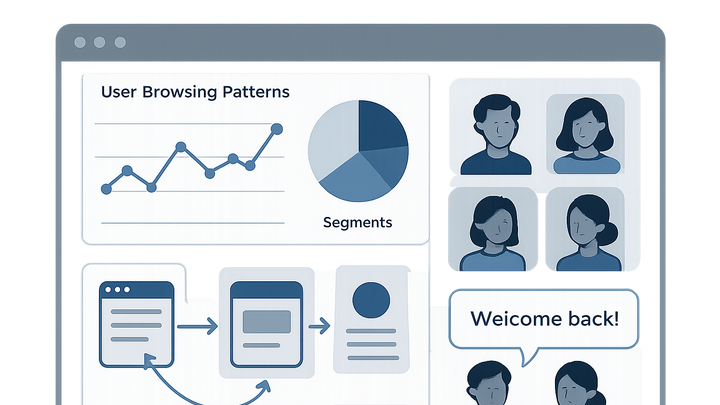Published on 2025-06-29T20:56:28Z
What is Behavioral Targeting? Examples and Best Practices for CRO/UX/SEO
Behavioral targeting uses visitors’ online actions—such as page views, clicks, and session duration—to tailor website content and messaging for different user segments. In website critiques for CRO, UX, and SEO, it enables site owners to deliver personalized experiences that drive conversions, improve usability, and enhance search engine signals. By analyzing behavioral data with tools like Prevue.me, teams can identify high-intent audiences, optimize landing pages dynamically, and refine calls-to-action to match user intent. When applied responsibly, behavioral targeting fosters more relevant user journeys, boosts lead generation, and elevates overall site performance.
Behavioral targeting
Use visitor behavior data to personalize content and messaging, improving conversion rates, UX, and SEO.
Why Behavioral Targeting Matters
Behavioral targeting drives personalization by using real user data to align website content and design with visitor intent. This leads to higher conversions, better user satisfaction, and stronger SEO signals.
-
Boosting conversion rates
By delivering personalized offers and content, behavioral targeting increases relevance and encourages visitors to complete desired actions, such as filling out forms or making purchases.
- Dynamic call-to-actions:
Tailor CTAs based on user journey stage to boost engagement and click-through rates.
- Personalized landing pages:
Serve different page variations to new vs. returning visitors for higher conversion.
- Dynamic call-to-actions:
-
Enhancing user experience
Personalized experiences make navigation intuitive and content relevant, leading to longer session times and reduced bounce rates.
- Content recommendations:
Suggest articles or products based on browsing history to keep users engaged.
- Adaptive navigation:
Adjust menus and links based on user interests for smoother site exploration.
- Content recommendations:
-
Improving seo signals
Increased dwell time, lower bounce rates, and higher engagement from personalized experiences send positive signals to search engines, potentially boosting organic rankings.
- Lower bounce rates:
Relevant content reduces bounce, signaling quality to search engines.
- Increased dwell time:
Personalized content keeps users on page longer, enhancing SEO performance.
- Lower bounce rates:
Implementing Behavioral Targeting
Effective behavioral targeting relies on systematic data collection, careful segmentation, and dynamic content delivery. These steps ensure that every user interaction is leveraged to create more relevant experiences.
-
Data collection
Collect first-party behavioral data through analytics tools to understand user interactions.
- First-party cookies:
Use cookies to track page views, clicks, and session duration.
- Event tracking:
Implement analytics events for form submissions, video plays, and downloads.
- First-party cookies:
-
Audience segmentation
Divide users into meaningful segments based on behavior patterns.
- Cart abandoners:
Target users who added items to carts but didn’t complete purchase.
- Frequent visitors:
Identify loyal visitors and serve tailored loyalty offers.
- Cart abandoners:
-
Personalized content delivery
Use segmentation to deliver dynamic content, messages, and offers.
- Dynamic banners:
Show different banners to segments based on interest or stage.
- Email personalization:
Send targeted follow-up emails reflecting past interactions.
- Dynamic banners:
-
Tools and platforms
Leverage specialized SaaS products for setup, analysis, and execution.
- Prevue.me:
Provides actionable CRO, UX, SEO, and accessibility critiques based on user behavior.
- Google optimize:
Run A/B tests and personalize web experiences for defined segments.
- Hotjar:
Visualize user behavior with heatmaps and session recordings.
- Prevue.me:
Examples of Behavioral Targeting
Real-world applications illustrate how behavioral targeting drives results across different website types and industries.
-
Prevue.me website critique example
prevue.me analyzes visitor data to recommend dynamic CTAs and content blocks that resonate with user intent.
- Dynamic copy adjustment:
Adjust headlines to highlight features based on prior page views.
- Segment-specific ctas:
Serve different CTAs to new vs. returning visitors for maximum relevance.
- Dynamic copy adjustment:
-
E-commerce upsell strategy
An online store uses browsing and purchase history to present related products and time-sensitive offers to cart abandoners.
- Product recommendations:
Display ‘You might also like’ based on past views and purchases.
- Abandoned cart emails:
Send personalized emails reminding users of items left in cart.
- Product recommendations:
-
Saas landing page personalization
A B2B SaaS uses firmographic and behavioral data to customize landing page messages and feature highlights for enterprise vs. SMB visitors.
- Custom value propositions:
Show enterprise-specific ROI metrics to corporate site visitors.
- Tailored feature demos:
Offer demos of features most relevant to small business users.
- Custom value propositions:
Best Practices and Pitfalls
Follow these guidelines to ensure effective, ethical, and compliant behavioral targeting efforts.
-
Data privacy and compliance
Ensure GDPR, CCPA, and other regulations are met when collecting and using behavioral data.
- Consent management:
Deploy cookie banners and obtain explicit consent for tracking.
- Data minimization:
Collect only necessary data and delete old records regularly.
- Consent management:
-
Balance personalization with privacy
Avoid overly intrusive personalization that may discomfort users.
- Maintain anonymity:
Use aggregated data where possible without identifying individuals.
- Transparent messaging:
Inform users how their data enhances their experience.
- Maintain anonymity:
-
Continuous testing and optimization
Regularly A/B test and refine segmentation criteria and content strategies.
- Iterative a/b testing:
Test one variable at a time to pinpoint what drives engagement.
- Performance monitoring:
Track KPIs like conversion, bounce rate, and time on site for each segment.
- Iterative a/b testing:
-
Integration with cro/ux/seo strategy
Align behavioral targeting tactics with broader optimization goals.
- Holistic analytics:
Combine behavioral data with technical SEO audits and UX research.
- Cross-functional collaboration:
Coordinate between marketing, design, and development teams for cohesive execution.
- Holistic analytics:
